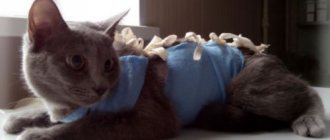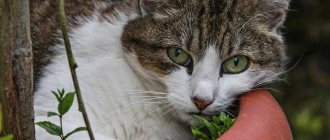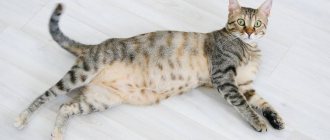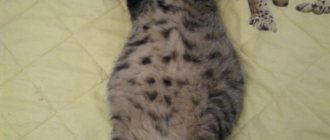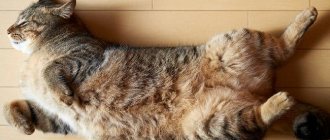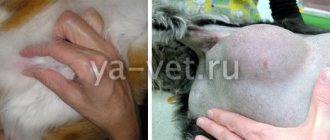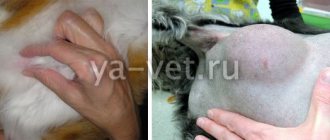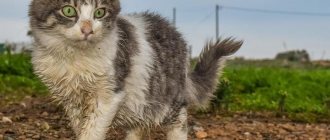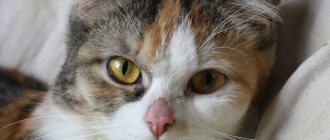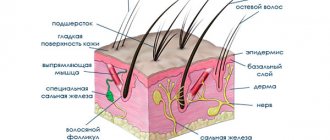A swollen and hard belly is a rather alarming symptom that accompanies many pathologies. One of them is ascites, or dropsy, which is often found in cats. It is not an independent disease and develops as a complication of pathological processes affecting the abdominal organs. To eliminate it, it is very important to determine the root cause, since relieving existing symptoms will only bring relief for a limited time.
What is abdominal ascites in cats and cats?
Normally, there is a small amount of fluid in the abdominal cavity of cats and kittens. It washes the internal organs, facilitating the movement of intestinal loops and helping the immune system. With its help, toxins and harmful microorganisms smoothly leave the body without having time to penetrate healthy cells and cause significant harm.
As a result of impaired absorption and blood circulation, the amount of fluid increases due to transudate or exudate. Unusual volume leads to increased pressure. The internal organs, shrinking, gradually lose their functionality, so without timely help the animal may die.
Therapeutic measures
Many owners, faced with a similar problem, are interested in how to treat ascites in a cat. Modern medicine does not have the ability to effectively treat liver ascites in cats over a long period of time.
Seizures in cats - main causes, symptoms, first aid, treatment and choice of drugs (110 photos)Polycystic kidney disease in cats - causes, diagnosis and symptoms of the disease. Treatment options and prevention of kidney disease (95 photos)
Tartar in cats - signs of the disease and methods of fully treating tartar (125 photos + video)
Long-term use of medications entails a significant loss of potassium, and diuretic drugs can aggravate the situation.
Medicines aimed at preserving potassium can cause hormonal imbalance.
During the treatment of ascites in a cat, it is recommended to limit salt intake. The drug Lazartan is considered the most effective, but the drug causes difficulties in use in veterinary medicine.
When pumping fluid from the abdominal cavity of an animal, albumin should be used. This will restore the lost supply of nutrients: amino acids, immune complexes, proteins and electrolytes.
Treatment is recommended to be carried out within a hospital; moreover, its quality differs in many respects from home treatment.
Causes of fluid accumulation
The risk group includes animals with congenital and acquired pathologies, which are the main causes. These include:
- Diseases of the cardiovascular system. Heart failure disrupts natural blood circulation, which causes an increase in internal pressure and increased vascular permeability.
- Abdominal injuries that provoke the development of swelling, inflammation and internal bleeding.
- Liver and kidney diseases. Disturbance in the functioning of the urinary system organs leads to acute intoxication with decay products and inflammation.
- Parasitoses and infections of various etiologies. Toxins released by pathogenic microorganisms irritate the receptors of the mucous membrane. To destroy them, the body launches an inflammatory reaction, accompanied by abundant production of exudate.
- Disturbances in the functioning of the endocrine system. Provoking factors are diabetes, excess weight and high cholesterol.
- Malignant neoplasms. Cancer cells clog lymphatic vessels, disrupting natural circulation and increasing the permeability of the walls.
Sometimes the owner is to blame for the excess amount of fluid in a cat’s stomach because he does not pay enough attention to the balance of the diet and the frequency of feedings. Complications can occur due to insufficient amounts of proteins or vitamins, as well as sodium abuse.
Prevention and care
As with any disease, after treatment, dropsy in cats requires preventive measures. After surgery, your pet requires special care in a quiet environment.
Preventive measures include regular monitoring of the animal’s health by a specialist. In addition, it is necessary to completely cure him of chronic diseases, which from time to time can be the main irritants of such ailments as ascites.
Preventative measures also include restoring proper nutrition for the pet. Food is one of the most influential factors on an animal's health. The diet should be saturated with the required amount of proteins, fats and carbohydrates.
An active lifestyle for a cat can save him from accumulating excess calories. Different degrees of obesity can become conductors not only for ascites, but also for other serious diseases of cardiac inclination.
What does ascites look like in a cat: main symptoms
Dropsy in cats develops gradually and responds well to treatment in the early stages. A rapid increase in alarming symptoms and a sharp deterioration in condition are typical for pets with weakened immune systems.
One of the main signs of pathology is an enlarged abdomen. It swells and loses its elasticity. When pressing inside, you can feel the movement of water.
These symptoms are similar to ordinary overeating, so to confirm your guesses, do a small test. Lift the animal up, holding it by the armpits. With stagnation, all the contents will rush down, giving the stomach a pear-shaped shape. After placing the cat on four paws, the shape will again become round.
In addition to changes affecting the peritoneum, it is necessary to highlight several more signs:
- yellowing of mucous membranes;
- dulling of fur;
- swelling of the limbs, groin, chest and ears at the base.
All other symptoms will depend on the cause of the illness. In addition to lethargy, apathy and poor appetite, the pet may experience vomiting, stool disturbances, urinary retention, fever, shortness of breath and cough. The advanced form is accompanied by severe pain, so the mustachioed pet should be taken to an appointment at the veterinary clinic before they appear.
Diagnostics in a veterinary clinic
To make a diagnosis, it is necessary to verify the presence of the suspected pathology and find out the cause of its occurrence. For this purpose, the following studies are used:
- urine analysis to determine pathologies of the urinary system;
- blood biochemistry, revealing the presence of toxins that poison the liver;
- Ultrasound confirming the presence of effusion and its exact volume, the functionality of internal organs and the presence of tumors;
- X-ray, which helps to detect the consequences of mechanical injuries and monitor the situation not only in the peritoneum, but also in the chest;
- puncture (puncture with collection of a biological sample) used to determine the composition of the fluid (exudate or transudate).
Also, the veterinarian must palpate (feel) the abdomen and collect anamnesis. After receiving the results of all studies, individual treatment is selected for the mustachioed patient.
Diagnostic measures
After the animal arrives at the veterinary clinic, the doctor begins an examination. During palpation, a significant increase in the walls of the peritoneum is detected.
The veterinarian should gather as much information as possible regarding the symptoms, especially their duration and severity.
The liquid is subjected to laboratory testing. A puncture is made to collect the material. At the same time, urine and blood tests are performed, as well as radiography and ultrasound.
In most cases, the disease develops within a few hours.
Is hydrops of the abdominal cavity curable in cats?
For your pet to recover, the underlying disease must be eliminated. If it is diagnosed in a timely manner and can be treated, the prognosis is positive.
If the pathology is incurable or detected too late, then treatment is reduced to maintenance therapy. It helps prolong life, but does not eliminate the problem. This situation is typical in oncology, cirrhosis and advanced peritonitis.
If the cause of the disorder lies in an immune failure, then the likelihood of relapse is high. In this case, the animal will have to regularly take anti-inflammatory drugs and diuretics, and also visit a veterinarian to pump out excess transudate.
How to prevent the development of pathology
Dropsy of the abdomen is a symptom of an underlying disease. Prevention will prevent the development of the disorder. It comes down to the overall health of your pet.
Preventive measures are as follows:
- proper feeding - eating economy-class food or unbalanced food leads to the development of pathologies of the kidneys, gastrointestinal tract, pancreas and liver;
- preventive visits to the veterinarian every 6 months;
- carrying out regular vaccinations - infectious diseases disrupt the functioning of internal organs, leading to the development of dropsy;
- treatment for worms once every 2 months - parasites lead to chronic intoxication, causing diseases of the internal organs;
- Contact a veterinarian immediately if a problem in your pet’s condition is detected.
Dropsy develops against the background of the underlying pathology. Keeping your cat healthy will help avoid problems.
Therapy methods
In addition to eliminating the root cause, treatment of abdominal ascites in cats involves relieving the main symptoms and removing accumulated fluid. In most cases, therapy is limited to taking medications, but sometimes it is necessary to resort to surgery.
Traditional drug treatment
The basis of drug treatment are diuretics (diuretics), which eliminate congestion by stimulating urination. All other drugs will depend on the diagnosis. These may include:
- analgesics necessary to suppress acute pain;
- cardiotonics that increase heart rate;
- antiemetics, weakening the gag reflex;
- potassium chloride and vitamin K, which reduce the permeability of blood vessels and strengthen their walls;
- antipyretics and sedatives;
- cephalosporin antibiotics that fight infection;
- colloidal solutions that increase the percentage of protein;
- immunomodulators that protect against secondary infection.
It is recommended to take all medications strictly as prescribed by your veterinarian. Incorrect dosage calculation or ending treatment too early can result in worsening of the condition and even death.
Drainage and surgery
Pumping out using puncture of the abdominal wall is resorted to in case of ineffectiveness of drug therapy or when there is dangerously high pressure on the internal organs. The procedure is carried out under anesthesia and repeated at least 2 times a week. This frequency and the need to use an anesthetic increases the risk of complications.
Surgery may be required if there is internal bleeding due to injury or oncology, as well as with purulent or necrotic processes. Depending on the problem, the surgeon excises pathological tissues and restores the integrity of damaged organs.
Folk remedies and help at home
The use of traditional medicine is permissible only as additional therapy and under the strict supervision of a veterinarian. Infusions and decoctions cannot eliminate the disease itself, but will alleviate its symptoms.
Self-medication using recipes found on the Internet or received from friends is unacceptable. Herbs often cause allergic reactions and are not always compatible with doctor-approved medications. Such help can result in the death of your pet, so do not try to solve the problem on your own.
If you find yourself far from the city and cannot get to a veterinary clinic in the near future, prepare an infusion of birch leaves. Pour boiling water over them in a ratio of 1:10, let it brew for 6 hours and strain. Give the resulting medicine twice a day, 1 teaspoon.
Despite the harmlessness of such an anesthetic, it is better to contact your doctor at least by phone and clarify the safety of the actions you are performing.
Nutrition correction and diet
Once the condition has stabilized, hydrops of the abdomen in cats is treated at home. In addition to taking medications, it is necessary to review your current diet:
- The amount of water and salt is kept to a minimum.
- The daily menu is adjusted in favor of meat and dairy products enriched with proteins. Twice a week, chicken, turkey or beef can be replaced with sea fish.
- The lack of vitamins and minerals is compensated by special additives to dishes.
If your pet suffers from diarrhea, then to strengthen the stool, he needs to be given rice porridge or a decoction. It is recommended to boil or steam meat and fish. This processing method will make it easier to digest.
When dry feeding, the usual food will have to be changed to veterinary food. Your doctor will help you decide on the exact brand, since a sudden switch to a new manufacturer can cause digestive upset.
Features of kitten treatment
Ascites in a kitten is treated according to general recommendations with minor differences. They consist of lower dosages and a ban on the use of immunomodulators. The first feature is explained by lower weight, and the second by the need to develop independent immunity. Taking such drugs for up to 1 year can lead to a malfunction in the immune system, resulting in the inability to distinguish healthy cells from infected ones.
